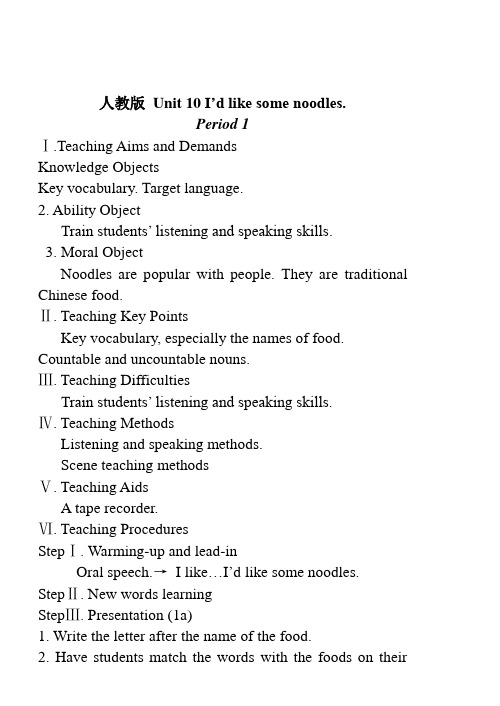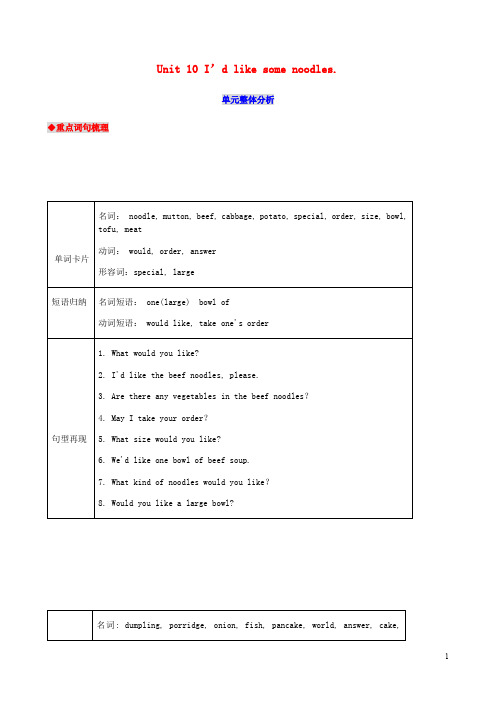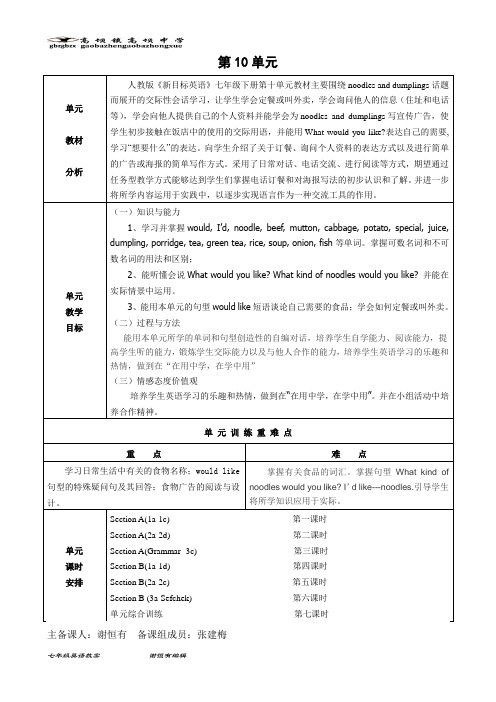公开课人教新目标英语7年级下册U10 I'd like some noodles
- 格式:doc
- 大小:23.50 KB
- 文档页数:3

人教版Unit 10 I’d like some noodles.Period 1Ⅰ.Teaching Aims and DemandsKnowledge ObjectsKey vocabulary. Target language.2. Ability ObjectTrain students’ listening and speaking skills.3. Moral ObjectNoodles are popular with people. They are traditional Chinese food.Ⅱ. Teaching Key PointsKey vocabulary, especially the names of food. Countable and uncountable nouns.Ⅲ. Teaching DifficultiesTrain students’ listening and speaking skills.Ⅳ. Teaching MethodsListening and speaking methods.Scene teaching methodsⅤ. Teaching AidsA tape recorder.Ⅵ. Teaching ProceduresStepⅠ. Warming-up and lead-inOral speech.→I like…I’d like some noodles.StepⅡ. New words learningStepⅢ. Presentation (1a)1. Write the letter after the name of the food.2. Have students match the words with the foods on theirown.3. Go over the answers.StepⅣ. Listening (1b)Listen and put a check before the noodles the man ordered.StepⅤ. Pairwork(1c)Ask students to practice similar conversations in pairs.Students take turns to be the customer and the noodles maker.StepⅥ. Summary and homeworkRemember the words and practice the target language.Period 2Ⅰ.Teaching Aims and Demands1. Knowledge ObjectsTarget languageAbility ObjectTrain students’ listening and speaking skills.Train students’ communicative competence.Moral ObjectNoodles are popular with people. They are traditional Chinese food.Ⅱ. Teaching Key PointsThe target language used for ask for and give personalinformation.Order food.Ⅲ. Teaching DifficultiesTrain students’ listening and speaking skills.Train students’ communicative competence.Ⅳ. Teaching MethodsListening and speaking methods. Scene teaching methodsⅤ. Teaching AidsA tape recorderⅥ. Teaching ProceduresStepⅠ. Warming-up and revisionOral speech and free talk.StepⅡ. Listening (2a 2b)1. You’re to listen and check the names of the foods you hear on the tape.2. Play the recording twice. Then check the answers.3. Play the same recording again. Listen carefully and fill in the blanks.StepⅢ. Pairwork (2c,2d)1. Work with a partner. One is a customer and the other is a waiter.2. Invite several pairs of students to act out their conversations in front of the class.3.Have some students role-play the conversations in pairs,then explain it to the class.StepⅣ. Grammar FocusGuide the students to make some sentences with I’d, He’d and They’d.StepⅤ. Conversation practice (3a ,3b)1. You are to match each question with an answer.2. Get students to do the task in pairs.3. Put students into pairs. One is working in a noodles house. The other is the customer. Get the pairs to start the activity.StepⅥ. Summary and homework1. Summary the target language we’ve learned in this class.2. Reread the conversation in 3a. try to recite it.3. Write down the conversation in 3c.Period 3Ⅰ. Teaching Aims and DemandsKnowledge ObjectsKey vocabulary. Target language.2. Ability ObjectTrain students’ listening and speaking skills.Train students’ communicative competence.3. Moral ObjectEveryone should choose foods which are good for his health.Ⅱ. Teaching Key PointsLearn how to ask for and give personal information and write down the information.Ⅲ. Teaching DifficultiesLearn how to ask for and give personal information and write down the information.Ⅳ. Teaching MethodsPracticing methods. Scene teaching methodsⅤ. Teaching AidsA tape recorderⅥ. Teaching ProceduresStepⅠ.Warming-up and lead-inOral speech. Describe one’s preferences.StepⅡ. New words learning.Porridge onion fish pancakeStepⅢ. Presentation (1a 1b)1. Match the words with the pictures. Write the letter of the food on the blank line before its name.2. Circle the things you like in the picture. And make an “×” next to the things you don’t like.StepⅣ. Listening (1c,1d)1. Listen carefully and circle in activity 1a the words that you hear on the tape.2. Play the same recording again. Write down the customer’s address, telephone number and what he orders.3.Check the answers.StepⅤ. Pairwork (2a)1. Put students into pairs. Ask questions about what they door eat on their birthdays.2. Invite more advanced students to demonstrate how to do the activity.StepⅥ.Summary and homeworkRemember the key words and target language.Period 4Ⅰ. Teaching Aims and DemandsKnowledge ObjectsLearn to read and write an ad for House of Dumplings.2. Ability ObjectTrain students’ reading and writing skills.Train students’ integrating skills.3. Moral ObjectKeep healthy.Ⅱ. Teaching Key PointsLearn how to order food.Learn to write an ad for House of Dumplings.Ⅲ. Teaching DifficultiesLearn how to order food.Learn to write an ad for House of Dumplings.Ⅳ. Teaching Methodsreading and writing methods. Practicing methodsⅤ. Teaching AidsA tape recorderⅥ. Teaching ProceduresStep I. Warming-up and revisionOral speech and dictation.Step II.Reading and answering(2b,2c)Do 2b:Ask students to read the article and complete the chart,then check the answers.Explain the key points to the class.Do 2c:Have students read the article again and answer the questions,then check the answers.Step III. Reading (3a)Fill in the blank lines, using words from the box.Get students to complete the paragraph on their own.Step IV. Writing (3b,3c)1. Write your own ad. Please use the ad in activity 3a as a model.2. Use the sample version in activity 1c to demonstrate how to order a meal.3.Have some students to read their ads to the class.Step V. PairworkLet students work in pairs to order meal. Students practice both roles.Step VI. Summary and homeworkOrder food.Period 5Ⅰ. Teaching Aims and DemandsKnowledge ObjectsReview the names of foods and drinks, the target language used to order food, ask for and give personal information and design an ad.2. Ability ObjectTrain students’ communicative competence.3. Moral ObjectNoodles, a kind of fast food, helps save a lot of time. And it’s delicious and rich in nutrient, thank th e inventor.Ask your family members or classmates what they’d like to eat. In this way, you will understand each other better. Ⅱ. Teaching Key PointsReview all the key words and order food.Review to ask for and give personal information.Ⅲ. Teaching DifficultiesOrder food, design an ad for House of Dumplings.Ⅳ. Teaching MethodsPracticing methods.Ⅴ. Teaching AidsⅥ. Teaching ProceduresStepⅠ.Warming-upStepⅡ. Review the key vocabularyGive students several minutes to memorize the key vocabulary.Large, medium, noodles, beef, mutton, chicken, cabbage,potatoes, tomatoes, dumplings, soup, green tea, orange juice.StepⅢ. Self Checks1, 2 ,3Do Self Check1. Ask students to check all the words they know. Write five new words in their V ocab-builder.Do Self Check2. Ask students to complete the task,then have some students read the 3 conversations to the class in pairs.Do Self Check3. Ask students to write a conversation with the help of the clues in pairs,then have some pairs read their conversations to the class.StepⅣ. Review the target languageMake a conversation use the target language.What kind of noodles would you like? →I’d like beef noodles.What size bowl of noodles would you like?→I’d like a small/medium/large bowl of noodles.What’s your address? →My address is ….Get several pairs of students to act out their conversations. StepⅤ.Summary and homeworkSummary the language we’ve learned in this unit.Finish 3c as your homework.。



Unit 10 I’d like some noodles.单元整体分析◆重点词句梳理◆教材内容解本单元的中心话题是“就餐”。
Section A部分有三个方面的内容:一是有关食品的词汇mutton, beef, noodles, chicken, cabbage, potato, tomato, carrot等;二是食品名词中的可数名词与不可数名词的用法;三是订餐或叫外卖等的用语。
Section B部分重点是关于订餐的主题内容和语言表达。
通过打电话订餐的情境,让学生感悟订餐时所用句型结构。
阅读篇章通过对全世界各种各样的生日食品的介绍,了解世界各地的饮食文化,生日文化等事情,使学生们具有初步的世界文化观念。
◆功能话题应用What kind of noodles would you like?I’d like beef and tomato noodles, please.What size would you like?I’d like a small/ medium/ large bowl.Would you like any drinks?One large green tea.◆语法结构点击1. would like的用法2. some与any的用法3. 可数名词与不可数名词的用法背景知识链接◆The history of pizza比萨饼是意大利人发明的吗?Italian pizza is very famous. Many people think that pizza comes from Italy, but it is wrong. The first pizza didn’t appear (出现) in Italy.Long long ago, the early Greeks first made large, round and flat (扁平的) bread. When they made the bread, they put many things over the bread, such as tomatoes, potatoes, meat and other things. Their bread tasted (尝起来) very good.Later, the idea of flat bread found its way to Italy. In the 18th century, Italian people called the flat bread “pizza”. They sold it on the streets and at the markets. Pizza was very cheap. Many people liked it.Now pizza is very popular around the world. It tastes better and better.Section A新课备课素材◆素材一新课导入设计导入一图片导入: show some pictures about food, meat and vegetables; Then ask and answer: What's your favorite food/drink/vegetables? Lead to the new words and sentences with the pictures; then lead to the new lesson.导入二Pandora's box: The teacher prepare a box and write these words :food, meat, vegetables and drink on some pieces of paper. Then put them into the box. Ss extract a card and say the导入三Brainstorming: Write down the words as many as possible about food, meat and vegetables; And then lead to the new lesson.◆素材二新课活动案例活动 1 : Which restaurant is the most special?If you have a special restaurant, please make a menu yourself.Then show your menu to other Ss.活动 2:Who is the fastest?(详见PPT)活动 3 Role-play(分角色表演,学生分组模拟餐馆场景编演对话。

第10单元单元教材分析人教版《新目标英语》七年级下册第十单元教材主要围绕noodles and dumplings话题而展开的交际性会话学习,让学生学会定餐或叫外卖,学会询问他人的信息(住址和电话等),学会向他人提供自己的个人资料并能学会为noodles and dumplings写宣传广告,使学生初步接触在饭店中的使用的交际用语,并能用What would you like?表达自己的需要,学习“想要什么”的表达。
向学生介绍了关于订餐、询问个人资料的表达方式以及进行简单的广告或海报的简单写作方式。
采用了日常对话、电话交流、进行阅读等方式,期望通过任务型教学方式能够达到学生们掌握电话订餐和对海报写法的初步认识和了解。
并进一步将所学内容运用于实践中,以逐步实现语言作为一种交流工具的作用。
单元教学目标(一)知识与能力1、学习并掌握would, I’d, noodle, beef, mutton, cabbage, potato, special, juice, dumpling, porridge, tea, green tea, rice, soup, onion, fish等单词。
掌握可数名词和不可数名词的用法和区别;2、能听懂会说What would you like? What kind of noodles would you like? 并能在实际情景中运用。
3、能用本单元的句型would like短语谈论自己需要的食品;学会如何定餐或叫外卖。
(二)过程与方法能用本单元所学的单词和句型创造性的自编对话,培养学生自学能力、阅读能力,提高学生听的能力,锻炼学生交际能力以及与他人合作的能力,培养学生英语学习的乐趣和热情,做到在“在用中学,在学中用”(三)情感态度价值观培养学生英语学习的乐趣和热情,做到在“在用中学,在学中用”。
并在小组活动中培养合作精神。
单元训练重难点重点难点学习日常生活中有关的食物名称;would like 句型的特殊疑问句及其回答;食物广告的阅读与设计。

人教新目标版英语七下Unit 10《I’d like some noodles》(Section A grammarfocus-3c)教学设计一. 教材分析人教新目标版英语七下Unit 10《I’d like some noodles》主要介绍了关于餐厅点餐的交际用语。
本节课的主要内容是让学生掌握情态动词can的用法,能够用情态动词can询问对方能否做某事,以及用情态动词can回答对方的问题。
同时,学生还需要掌握关于 noodles, rice, chicken, beef等食物的表达方式。
本节课的教学重点是让学生能够正确使用情态动词can进行交际,教学难点是让学生能够熟练运用情态动词can进行询问和回答。
二. 学情分析七年级的学生已经掌握了情态动词can的基本用法,能够用情态动词can表达自己的能力。
但是,学生在实际交际中,还不能熟练运用情态动词can进行询问和回答。
因此,在教学过程中,需要通过各种教学活动,让学生在实际交际中运用情态动词can,从而提高学生的交际能力。
三. 教学目标1.知识目标:学生能够掌握情态动词can的用法,能够用情态动词can询问对方能否做某事,以及用情态动词can回答对方的问题。
学生还能够掌握关于 noodles, rice, chicken, beef等食物的表达方式。
2.能力目标:学生能够在实际交际中,熟练运用情态动词can进行询问和回答。
3.情感目标:通过本节课的学习,学生能够增强对英语学习的兴趣,提高自信心。
四. 教学重难点1.重点:学生能够正确使用情态动词can进行交际。
2.难点:学生能够熟练运用情态动词can进行询问和回答。
五. 教学方法本节课采用任务型教学法,通过各种任务活动,让学生在实际交际中运用情态动词can,从而提高学生的交际能力。
同时,采用合作学习法,让学生在小组合作中完成任务,培养学生的团队协作能力。
六. 教学准备1.教师准备:教师需要准备教学PPT,包括情态动词can的用法介绍,以及关于 noodles, rice, chicken, beef等食物的图片。
人教版新目标英语七年级下册《Unit 10 I’d like some noodles》教学设计一. 教材分析人教版新目标英语七年级下册Unit 10 “I’d like some noodles”主要教学目标是让学生掌握关于食物和饮料的词汇,如noodles, dumplings, rice, vegetables, fruit, milk, water等,并能够用“I’d like…”的结构来表达自己的喜好。
同时,学生还需要学会如何用“How much is…?”来询问价格。
二. 学情分析七年级的学生已经掌握了基本的日常英语对话,对于食物和饮料的词汇也有所了解,但可能对于一些表达喜好和询问价格的句型还不够熟悉。
此外,学生的听说能力和团队协作能力有待提高。
三. 教学目标1.能够听懂、会说、会读关于食物和饮料的词汇。
2.能够用“I’d like…”的结构来表达自己的喜好。
3.学会用“How much is…?”来询问价格。
4.提高学生的听说能力和团队协作能力。
四. 教学重难点1.词汇:noodles, dumplings, rice, vegetables, fruit, milk, water等。
2.句型:“I’d like…”和“How much is…?”的用法。
五. 教学方法采用任务型教学法,通过小组合作、角色扮演、听力练习等多种方式,激发学生的学习兴趣,提高学生的听说能力和团队协作能力。
六. 教学准备1.教学PPT,包含食物和饮料的图片及价格。
2.食物和饮料的实物或图片。
3.听力材料。
4.分组合作的任务卡。
七. 教学过程1.导入(5分钟)利用食物和饮料的实物或图片,引导学生谈论他们喜欢吃的食物。
教师可以提问:“What’s your favorite food?”,让学生用“I’d like…”的结构来回答。
2.呈现(10分钟)通过PPT展示本课要学习的食物和饮料词汇,如noodles, dumplings, rice等,并配以图片,让学生听音辨物。
人教版新目标英语七年级下册《Unit 10 I’d like some noodles》优质课说课稿一. 教材分析人教版新目标英语七年级下册《Unit 10 I’d like some noodles》是一篇以日常饮食为主题的教学内容。
本节课的主要目的是让学生掌握如何使用英语描述自己喜欢的食物以及点餐的基本句型。
通过本节课的学习,学生能够听懂、会说、会读关于食物和点餐的英语句子,并能够运用所学知识进行简单的实际操作。
二. 学情分析针对七年级的学生,他们对英语已经有了一定的基础,能够听懂并简单运用一些基本的英语句型。
但是,对于一些关于食物和点餐的专业词汇和句型,他们可能还比较陌生。
因此,在教学过程中,需要注重引导学生掌握新词汇和句型,并能够灵活运用到实际情境中。
三. 说教学目标1.知识目标:学生能够掌握关于食物和点餐的常用英语词汇和句型,如“would like”,“How about”,“I’d like some”等。
2.能力目标:学生能够听懂、会说、会读关于食物和点餐的英语句子,并能够运用所学知识进行简单的实际操作。
3.情感目标:通过本节课的学习,学生能够提高对英语学习的兴趣,培养良好的学习习惯。
四. 说教学重难点1.重点:学生能够听懂、会说、会读关于食物和点餐的英语句子。
2.难点:学生能够熟练运用所学知识进行实际点餐操作,并能够灵活运用词汇和句型。
五. 说教学方法与手段1.教学方法:采用任务型教学法,让学生在实际操作中掌握知识点。
2.教学手段:利用多媒体课件、图片、实物等辅助教学,提高学生的学习兴趣和参与度。
六. 说教学过程1.导入:通过展示一些食物图片,引导学生谈论自己喜欢的食物,激发学生的学习兴趣。
2.呈现:教师通过课件展示本节课的主要词汇和句型,让学生初步感知和理解。
3.操练:学生分组进行角色扮演,模拟点餐的场景,运用所学知识进行实际操作。
4.巩固:教师设计一些听力、口语练习,让学生进一步巩固所学知识。
XX初中
XX初中
XX
人教新目标七年级英语下册
授课人:XX
2016年6月1日
校际教研活动
Unit 10 I’d like some noodles.
(period one)
XX学校XX
I. Teaching Aims:
1. Knowledge goals: 1) Words about the foods we eat in our daily life
2)---- What would you like?
---- I’d like ......
2.Ability goals: To train students’ listening and speaking skills
To develop students’ ability of ordering food in English
3.Emotion goals: Eat healthy food and keep healthy
II. Teaching important and difficult points
1.New words
2.Learn to use “would like”
III. Teaching methods: Auto-nomous learning , communicative approach,listening,speaking
IV. Teaching aids: multimedia
V. Teaching procedures
Step1 lead in
1.Greet the students
2.Show two pictures of two cooks on the screen
Step2 presentation
1.New words
( Show students some pictures about the foods we eat in our everyday life)
2.Can you name the food?
3.Present “What would you like?”“ I’d like .....”
Step3 Practice
Students work in pairs to practice the target language with the new words
Then ask some pairs to show their conversations
Step4 Listening
1.Show the three specials in the noodle house ,preparing for the listening
2.Match the words with the pictures in 1a
3.Listen and check the answers
4.Students read the conversations in 1a after the recording
Step5 Pair work
Students practice the conversation in 1a and make new conversations.
Ask several pairs to show their conversations
Step6 Group work
Make a survey and give a report
“ What would you like to eat for breakfast /lunch / dinner?”
Name Food
1.
2.
3.
4.
“ Who eats healthy food in your group?”
( Divide all the students into three groups, and each group work on one topic. And divide them into a small group of four to do this survey )
Step 7 Summary
Key words: mutton ,beef , noodle , chicken, cabbage ,potato , tomato , carrot Key structure: would like
Step 8 Homework
1. Ask your parents what they would like to eat
2. Make five or ten sentences with “would like” and the words we’ve learnt today.
3. Finish the exercise book and preview for the next period.。